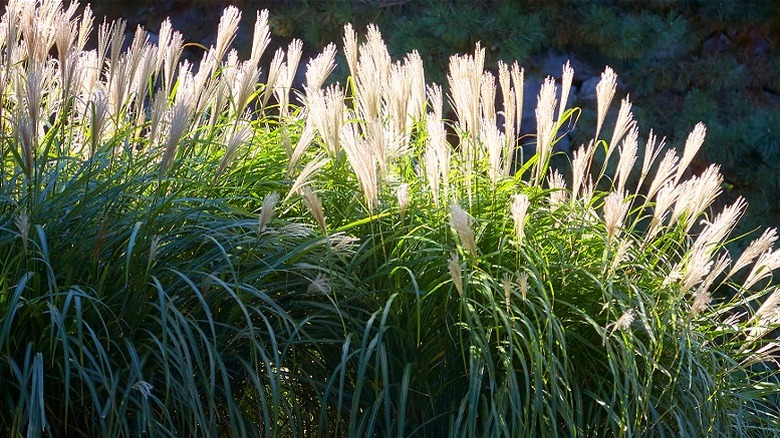The Perfect Companion Grass To Go With Your Cottage Garden
Cottage gardens can work in any space, whether small or large, but in feel, it's a more casual type of garden that bursts with flowers and a variety of ornamental plants. If you want to add height and interest to your cottage garden, consider adding zebra grass (Miscanthus sinensis) as a companion grass. This ornamental grass offers garden spaces a fabulous amount of color (and a bit of late-season drama, too). Though it's not hard to grow, zebra grass is a statement piece since it can grow quite tall, forms an arch, and develops plumes.
Zebra grass's descriptive name comes from its variegated appearance; specifically, the light-colored horizontal bands seen striping each blade. The plant features long, arching leaves that can soften the look of a garden. Further into the growing season, around late summer, flowers also appear with the grass, shooting out from the top in an almost wine-colored display. These plumes eventually turn silvery as the months go on, which means you can keep zebra grass growing in your cottage garden until they turn dormant in the winter.
Growing zebra grass in a cottage garden
The ideal zones for zebra grass are 5 to 9, but it can grow in many regions; the key is soil temperature, one that can reach at least 70 F. The grass also needs direct sunlight to thrive, especially if you're placing it in areas where temperatures drop. In warmer areas, the grass may do OK in partial shade, but be aware that it may not reach its full potential as far as height.
As far as soil, this ornamental grass does best in a neutral, pH-balanced soil. If you're going to improve the soil composition, use an organic material to do so. And though it needs moist soil, zebra grass also needs proper drainage. Sitting in saturated soil for too long will create damage to the root system, so keep the ground moist for the best results.
As a companion grass, zebra grass does well when paired with shorter plants as it prefers ample direct sunlight. With too much shade, the leaves will start to droop significantly, and that takes away from the overall structural features it can add to your cottage garden. As they grow taller, you can help support these grasses with a stake. Then, work to improve the amount of sunlight exposure, moisture, and overall nutrient access it has so it doesn't need to rely on staking long term.
Making the most of your cottage garden's zebra grass
To get the best overall results for your cottage garden's zebra grass, there are a few things to keep in mind. These plants can grow several feet a year before reaching their maximum height and can take over your cottage garden rather quickly if you're not careful. As a result, you will need to prune the grass to maintain its look. As said, though, the grass's plumes will emerge in late summer (or early fall), and continue to develop up until winter when it goes dormant. This makes winter a good time to prune the perennial.
Pruning zebra grass will help the plant focus on root development so it can flourish in your cottage garden the following spring. Once frost occurs, cut back the plant to just a few inches above the ground surface. The further good news about pruning zebra grass is that this is a great time, too, to take some of its long, fern-like cuttings into your home for a bit of décor or dry them out for your next floral project.


